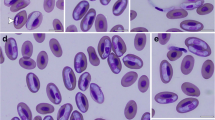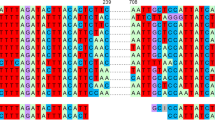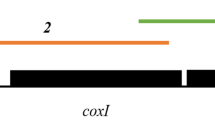Abstract
Intra-leukocytic gamonts consistent with the description of Hepatozoon griseisciuri Clark, 1958 are reported for the first time in Canadian eastern gray squirrels (Sciurus carolinensis Gmelin, 1788). Polymerase chain reaction (PCR) amplification and direct Sanger sequencing identified a pair of distinct genotypes at both a nuclear and mitochondrial locus; two 18S ribosomal RNA gene sequences (rDNA; genotype A and genotype B: 1816 base pairs (bp); 98.8% pairwise identity) and 2 distinct complete mitochondrial genome sequences (genotype A: 6311 bp; genotype B: 6114 bp; 89.1% pairwise identity) were obtained from 3 H. griseisciuri-infected squirrels sampled in Guelph, Ontario. The genetic content of both circular-mapping mitochondrial genomes was conventional for apicomplexan protists; each encoded for 3 protein-coding genes (cytochrome c oxidase subunit I (COI); cytochrome c oxidase subunit III (COIII); and cytochrome B (CytB)), 14 fragmented large subunit rDNA, 10 fragmented small subunit rDNA, and 8 unassigned rDNA. These genotypes, based on sequences obtained from a pair of loci from two parasite genomes, confirm the presence of at least two Hepatozoon species infecting Ontario eastern gray squirrels, one of which is likely to be conspecific with H. griseisciuri.


Similar content being viewed by others
References
Altschul SF, Gish W, Miller W, Myers EW, Lipman DJ (1990) Basic local alignment search tool. J Mol Biol 215:403–410. https://doi.org/10.1016/S0022-2836(05)80360-2
Baneth G, Barta JR, Shkap V, Martin DS, Macintire DK, Vincent-Johnson N (2000) Genetic and antigenic evidence supports the separation of Hepatozoon canis and Hepatozoon americanum at the species level. J Clin Microbiol 38:1298–1301
Barta JR (2000) Suborder Adeleorina Leger, 1911. In: Lee JJ, Leedale GF, Bradbury P (eds) An illustrated guide to the Protozoa, 2nd edn. Society of Parasitologists, Lawrence, Kansas, pp 305–318
Boratyn GM, Schäffer AA, Agarwala R, Altschul SF, Lipman DJ, Madden TL (2012) Domain enhanced lookup time accelerated BLAST. Biol Direct 7:1–15. https://doi.org/10.1186/1745-6150-7-12
Britt D, Molyneux DH (1979) Parasites of grey squirrels in Cheshire, England. J Parasitol 65:408. https://doi.org/10.2307/3280284
Clark GM (1958) Hepatozoon griseisciuri n. sp.; a new species of Hepatozoon from the grey squirrel (Sciurus carolinensis Gmelin, 1788), with studies on the lifecycle. J Parasitol 44:52–63. https://doi.org/10.2307/3274829
Coles AC (1914) Blood parasites found in mammals, birds and fishes in England. Parasitology 7:17–61. https://doi.org/10.1017/S0031182000006284
Davidson WR, Calpin JP (1976) Hepatozoon griseisciuri infection in gray squirrels of the southeastern United States. J Wildl Dis 12:72–76. https://doi.org/10.7589/0090-3558-12.1.72
Dorney RS, Todd AC (1959) Occurrence of Hepatozoon in Gray Squirrels in Wisconsin. J Parasitol 45:309. https://doi.org/10.2307/3274506
Feagin JE, Harrell MI, Lee JC, Coe KJ, Sands BH, Cannone JJ, Tami G, Schnare MN, Gutell RR (2012) The fragmented mitochondrial ribosomal RNAs of Plasmodium falciparum. PLoS One 7:e38320. https://doi.org/10.1371/journal.pone.0038320
Hendricks LD (1975) Schizogonic development of Hepatozoon griseisciuri Clark 1958 (Sporozoa: Haemogregarinidae), of the gray squirrel (Sciurus carolinensis Gmelin 1788). J Parasitol 61:458–461. https://doi.org/10.2307/3279324
Herman CM, Price DL (1955) The occurrence of Hepatozoon in the gray squirrel (Sciurus carolinensis). J Protozool 2:48–51. https://doi.org/10.1111/j.1550-7408.1955.tb02396.x
Hikosaka K, Kita K, Tanabe K (2013) Diversity of mitochondrial genome structure in the phylum Apicomplexa. Mol Biochem Parasitol 188:26–33. https://doi.org/10.1016/j.molbiopara.2013.02.006
Hikosaka K, Nakai Y, Watanabe Y, Tachibana S-I, Arisue N, Palacpac NMQ, Toyama T, Honma H, Horii T, Kita K, Tanabe K (2011a) Concatenated mitochondrial DNA of the coccidian parasite Eimeria tenella. Mitochondrion 11:273–278. https://doi.org/10.1016/j.mito.2010.10.003
Hikosaka K, Watanabe Y-I, Kobayashi F, Waki S, Kita K, Tanabe K (2011b) Highly conserved gene arrangement of the mitochondrial genomes of 23 Plasmodium species. Parasitol Int 60:175–180. https://doi.org/10.1016/j.parint.2011.02.001
Hikosaka K, Watanabe YI, Tsuji N, Kita K, Kishine H, Arisue N, Palacpac NMQ, Kawazu SI, Sawai H, Horii T, Igarashi I, Tanabe K (2010) Divergence of the mitochondrial genome structure in the apicomplexan parasites, Babesia and Theileria. Mol Biol Evol 27:1107–1116. https://doi.org/10.1093/molbev/msp320
Karadjian G, Chavatte J-M, Landau I (2015) Systematic revision of the adeleid haemogregarines, with creation of Bartazoon n. g., reassignment of Hepatozoon argantis Garnham, 1954 to Hemolivia , and molecular data on Hemolivia stellata. Parasite 22:31. https://doi.org/10.1051/parasite/2015031
Kearse M, Moir R, Wilson A, Stones-Havas S, Cheung M, Sturrock S, Buxton S, Cooper A, Markowitz S, Duran C, Thierer T, Ashton B, Meintjes P, Drummond A (2012) Geneious basic: an integrated and extendable desktop software platform for the organization and analysis of sequence data. Bioinformatics 28:1647–1649. https://doi.org/10.1093/bioinformatics/bts199
Léveillé AN (2019) Scratching the surface: Diversity among the first sequenced extrachromosomal genomes of parasites in the suborder Adeleorina (Apicomplexa) with a focus on Hepatozoon species. Doctor of Philosophy Dissertation, University of Guelph. http://hdl.handle.net/10214/16973
Léveillé AN, Baneth G, Barta JR (2019a) Next generation sequencing from Hepatozoon canis (Apicomplexa: Coccidia: Adeleorina): complete apicoplast genome and multiple mitochondrion-associated sequences. Int J Parasitol 49:375–387. https://doi.org/10.1016/j.ijpara.2018.12.001
Léveillé AN, Bland SK, Carlton K, Larouche CB, Kenney DG, Brouwer ER, Lillie BN, Barta JR (2019b) Klossiella equi infecting kidneys of Ontario horses: lifecycle features and multi locus sequence based genotyping confirm the genus Klossiella belongs in the Adeleorina (Apicomplexa: Coccidia). J Parasitol 105:29–41. https://doi.org/10.1645/18-80
Léveillé AN, Ogedengbe ME, Hafeez MA, Tu H-HA, Barta JR (2014) The complete mitochondrial genome sequence of Hepatozoon catesbianae (Apicomplexa: Coccidia: Adeleorina), a blood parasite of the green frog, Lithobates (formerly Rana) clamitans. J Parasitol 100:651–656. https://doi.org/10.1645/13-449.1
Maia JP, Carranza S, Harris DJ (2016) Comments on the systematic revision of adeleid haemogregarines: are more data needed? J Parasitol 102:549–552. https://doi.org/10.1645/15-930
Medlin L, Elwood HJ, Stickel S, Sogin ML (1988) The characterization of enzymatically amplified eukaryotic 16S-like rRNA-coding regions. Gene 71:491–499. https://doi.org/10.1016/0378-1119(88)90066-2
Miller WW (1908) Hepatozoon perniciosum (n.g., n.sp.) : a haemogregarine pathogenic for white rats, with a description of the sexual cycle in the intermediate host, a mite (Lelaps echidninus). Washington: Government Printing Office
Ogedengbe ME (2015) DNA barcoding of Apicomplexa: mitochondrial evolution across the phylum. Doctor of Philosophy Dissertation, University of Guelph
Ogedengbe JD, Hanner RH, Barta JR (2011) DNA barcoding identifies Eimeria species and contributes to the phylogenetics of coccidian parasites (Eimeriorina, Apicomplexa, Alveolata). Int J Parasitol 41:843–850. https://doi.org/10.1016/j.ijpara.2011.03.007
Parker JC (1968) Parasites of the gray squirrel in Virginia. J Parasitol 54:633. https://doi.org/10.2307/3277102
Redington BC (1970) Studies on the morphology and taxonomy of Haemogamasus reidi Ewing, 1925 (Acari: Mesostigmata). Acarologia 12:643–667
Redington BC, Jachowski LA (1971) Syngamy and sporogony of Hepatozoon griseisciuri Clark, 1958 (Sporozoa: Haemogregarinidae), in its natural vector, Haemogamasus reidi Ewing, 1925 (Acari: Mesostigmata). J Parasitol 57:953–960. https://doi.org/10.2307/3277842
Redington BC, Jachowski LA (1972) Role of Haemogamasus reidi (Acari: Mesostigmata) in the lifecycle of the gray squirrel protozoan, Hepatozoon griseisciuri (Sporozoa: Haemogregarinidae). J Parasitol 58:401–403. https://doi.org/10.2307/3278114
Sloboda M, Kamler M, Bulantová J, Votýpka J, Modrý D (2007) A new species of Hepatozoon (Apicomplexa: Adeleorina) from Python regius (Serpentes: Pythonidae) and its experimental transmission by a mosquito vector. J Parasitol 93:1189–1198. https://doi.org/10.1645/GE-1200R.1
Sloboda M, Kamler M, Bulantová J, Votýpka J, Modrý D (2008) Rodents as intermediate hosts of Hepatozoon ayorgbor (Apicomplexa: Adeleina: Hepatozoidae) from the African ball python, Python regius? Folia Parasitol (Praha) 55:13–16. https://doi.org/10.14411/fp.2008.003
Smith TG (1996) The genus Hepatozoon (Apicomplexa: Adeleina). J Parasitol 82:565–585. https://doi.org/10.2307/3283781
Watkins BM, Nowell F (1991) Hepatozoon in gray squirrels (Sciurus carolinensis) trapped near Reading, Berkshire. J Zool 224:101–112. https://doi.org/10.1111/j.1469-7998.1991.tb04791.x
Weidanz WP, Hyland KE (1958) The occurrence of Hepatozoon sciuri in gray squirrels in New England. J Parasitol 44:97. https://doi.org/10.2307/3274836
Acknowledgments
A.N.L. was supported by a Queen Elizabeth II Graduate Scholarship in Science and Technology and an Ontario Graduate Scholarship from the Government of Ontario, and an OVC Scholarship from the Ontario Veterinary College, University of Guelph. Dr. Darren Wood (Pathobiology, University of Guelph) is thanked for his assistance in the specific identification of parasitized squirrel leukocytes. Dr. Todd Smith, Perryn Kruth, Rachel Imai, and Jessica Rotolo are thanked for their comments on earlier drafts of this paper; Perryn Kruth is also thanked for her assistance with squirrel necropsies. The staff of the Guelph Molecular Supercenter, Laboratory Services Division, University of Guelph, are thanked for their diligent hard work.
Funding
This research was supported by a Discovery Grant to J.R.B. from the Natural Sciences and Engineering Research Council of Canada (NSERC-DG #400566).
Author information
Authors and Affiliations
Corresponding author
Ethics declarations
Conflict of interest
The authors declare that they have no conflict of interest.
Additional information
Section Editor: Domenico Otranto
Publisher’s note
Springer Nature remains neutral with regard to jurisdictional claims in published maps and institutional affiliations.
Rights and permissions
About this article
Cite this article
Léveillé, A.N., El Skhawy, N. & Barta, J.R. Multilocus sequencing of Hepatozoon cf. griseisciuri infections in Ontario eastern gray squirrels (Sciurus carolinensis) uncovers two genotypically distinct sympatric parasite species. Parasitol Res 119, 713–724 (2020). https://doi.org/10.1007/s00436-019-06583-5
Received:
Accepted:
Published:
Issue Date:
DOI: https://doi.org/10.1007/s00436-019-06583-5




